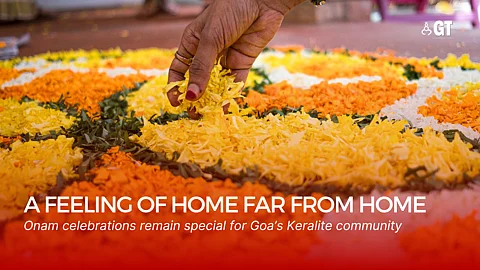

They say “home is where the heart is”. And moving away from a place that’s always been home is much scarier than one anticipates. It's no wonder people pack bits of their culture and traditions as final goodbyes are exchanged, hoping these will cause us to reminisce, bringing a feeling of home far from home.
When the Portuguese sailed away from the shores of Goa after liberation, Goa was left with a lot of vacancies in administrative positions that Goans back then lacked the competence to fill. And this is believed to have led many Keralites to migrate to the state of Goa.
Over the years, Goa’s Keralite community has spread in pockets across the state and have contributed substantially in almost every sphere. They’ve been an indispensable part of the service sectors, such as plumbers, carpenters, painters; they’ve served as professors, scientists, contactors, worked at the PWD and electricity departments and have played a major role in the development of the state of Goa.
Today, the community celebrates the much anticipated Onam, a ten-day harvest festival, with much splendour and dedication. Here are stories of food and festivities that have helped Keralites feel at home in Goa.
BRINGING AUTHENTIC KERALA FLAVOURS TO GOA THIS ONAM
No matter the benefits a new place offers, there's always a void, a pining for home. And the restaurant Mallu Republic in a way comforts all those far from home.
Started back in October 2021, Mallu Republic is a small food joint that specialises in Kerala cuisine. With the aim of bringing the taste and flavours of Kerala to Goa, the restaurant at St Inez, Panjim, has curated a menu that serves some delicious Kerala food at affordable prices.
"We started a Kerala restaurant in Goa keeping in mind all those Goans who travel to Gulf countries, indulge in some Kerala food and go on to love the experience," says Dennis Joseph, the owner of the restaurant.
He further adds that Kerala and Goa have a lot of similarities in their food, which could be due to Portuguese influence (the Portuguese first reached Kerala and then the state of Goa).
It's been estimated that around 26,000 Keralites live and work here in Goa. "We try our best to keep it simple. All our chefs are from Kerala and follow the most authentic way of cooking. In fact, most of our ingredients like spices, coconut oil, rice flour and coconut milk are all sourced from Kerala, directly from farmers," the owner highlights.
This Onam, the restaurant will be serving Onam sadhya (a multi-coursed vegetarian meal that's served on a banana leaf) comprising of about 23 items, including pal payasam, uppu and more.
"We are touching 720 orders for Onam already. About 600 booked from Manipal Hospital. Then our regular customers' orders are also on the rise. Approximately 850 sadhya meals will be served by us this year," Dennis mentions, further adding that due to the huge demand only orders made in advance will be available as takeaways.
With a customer base of about 5 per cent Mallus, the other customers are usually non-Malayalis who love exploring the menu serving chicken, mutton, beef, duck, quail and seafood at the restaurant. Apart from the festive season, the restaurant is highly patronised throughout the year, especially by Goans.
HOLDING ON TO TRADITIONS THROUGH ONAM CELEBRATIONS
Dr M R Ramesh Kumar is a retired chief scientist from the Physical Oceanography Division of the National Institute of Oceanography (NIO), Dona Paula, Goa. Although a Goan by origin, he’d migrated to Kerala some decades ago, only to return to his roots in 1982 as a trainee scientist at NIO, becoming a permanent staff member as a scientist a year later.
Since then, there have been attempts to recreate Onam festivities at the NIO colony by preparing Onam sadhya. Most of which is prepared at the members’ homes, except dishes like rice, sambhar and a few others that are prepared in bulk at NIO's community centre.
"We have several non- Malayali friends who feast on these dishes and varied payasams that are served on a plantain leaf," he says.
According to him, when it comes to food, people from Kerala and Goa love their seafood. In fact, fish, curry and rice (parboiled rice) are quite common in both the states’ cuisines.
He fondly remembers a time when he'd participated in Onam celebrations in Munich, Germany, at a church back in 1997. The many Keralites who've settled there celebrate the festival extensively.
"I always feel that people residing outside Kerala celebrate their festivals in a much better fashion than in Kerala itself," he opines.
On the festival day, there’s plenty of entertainment and programmes conducted for children and adults, including pookalam, singing, dancing, mono-act mimicry and the popular Mahabali or Maveli that's a must at all Onam celebrations.
Native festivals, in a way, help the Keralite community in Goa preserve their identity, especially in the case of the younger generations who risk slowly detaching from their culture.
"For instance, the current generation prefers pao or the Goan varieties of bread to traditional Kerala food items," Dr Kumar states, adding that it's these simple nostalgic elements that the older generations wish to retain when they settle away from home.
And there are quite a few Malayali associations or samajam in Goa who intend to do just that. They usually meet up and celebrate festivals like Onam on a grand scale with lots of cultural activities for all members with an amazing Onam sadhya.
Having made Goa their abode, the celebration of Onam brings the warmth of home to the many Keralites residing in Goa. They’ve adapted a few Goan ways but unite each year for festivities like these that have let them preserve a culture and a little of Kerala in their hearts.